

By: Jennifer Bloss, DVM
Brook-Falls Veterinary Hospital & Exotic Care
Menomonee Falls, WI
Many rabbits are presented to the veterinarian for Owners notice that their rabbit is not eating or defecating normally. This is always an emergency – the sooner your rabbit is treated the better! But it is also important to determine why this is happening and not just treat the symptoms. Stasis is not a disease that your rabbit can acquire – it is merely a symptom of something else going on. That is why a complete physical exam is the most important thing your veterinarian can provide for your rabbit.

Ear infection, glaucoma, dental disease, thymoma (tumor in the chest cavity), heart failure, pneumonia, liver lobe torsion, kidney disease, bladder infection, urine sludge, arthritis, or even a torn toenail are just a few of the problems that can cause stasis. Other causes include poor diet and . Anything that is painful for your rabbit or makes them just not feel good can cause stasis.
Long stem fiber in hay stimulates the gut to move. So, if your rabbit is not eating or drinking well, the gut slows down. Dehydration makes the gut contents thicker and more difficult to pass, allowing bacteria to pass from the gastrointestinal (GI) tract into the blood stream. Gas builds up causing more pain, which causes the gut to slow down further. Your rabbit ends up in a downwards spiral and can get very sick, very quickly.
The physical exam will help your veterinarian determine the best diagnostic tests to perform and the best course of treatment. Your rabbit’s temperature, hydration and attitude are the biggest indications of severity. A rabbit with a low temperature and a hunched posture is critical and needs hospitalization, but a rabbit with a normal temperature that is grooming itself and hopping about the exam room can likely be treated as an outpatient. Rabbits with hypothermia (low temperature) have a risk of mortality three times greater than rabbits with normal temperatures. Each 1°C decrease in rectal temperature doubles the risk of death. Your veterinarian will use a stethoscope to listen to the heart and lungs and the gut. A normal rabbit will usually have lots of gut sounds. Palpation of the abdomen can reveal pain, distention of the stomach or cecum with air, or a doughy hard stomach or cecum packed with food. Masses can also be found in the abdomen on palpation, the most common being uterine cancer in non- spayed female rabbits.
Diagnostic testing is usually required in rabbits presenting with stasis to help your veterinarian determine the cause and severity of the condition. The most common diagnostic test performed on sick rabbits is a radiograph (x-ray). This test gives your veterinarian the most information very quickly. Most rabbits are small enough that the entire body can fit on the x-ray plate. Many disease conditions can be ruled in or out through x-rays, and most importantly they offer a good look at the GI tract. Severe gas distension of the stomach, cecum or small intestines may indicate obstruction. These rabbits need hospitalization. However, a rabbit in “stasis” with a normal abdominal
radiograph can usually be treated as an outpatient. Bloodwork can help your veterinarian rule out metabolic problems such as liver and kidney disease, anemia, and infection. A rabbit with a greater than 2-3 times normal blood glucose is more likely to have a life-threatening intestinal obstruction that requires surgery.
Treatment of “stasis” is dependent on the primary cause. Sometimes the physical exam, x-rays and bloodwork do not lead your veterinarian to a primary diagnosis, so symptomatic treatment is started. Many of these rabbits need diet or husbandry changes. If your veterinarian determines that outpatient treatment is adequate, subcutaneous (SQ) fluids to prevent dehydration, injectable or oral pain medications and syringe feedings are usually started. Motility drugs to stimulate the gut to move can also be used, but they are not as important. Metoclopramide works to increase stomach contractions, while cisapride can increase motility over the entire GI tract.
If your rabbit presents with a severe pain, low temperature, dehydration, or signs of GI obstruction, they should be hospitalized at a 24- hour facility for intensive care. An intravenous (IV) catheter is placed to provide IV fluids to rehydrate the gut and the entire body to bring up blood pressure, patients are placed in incubators to normalize temperature, a nasogastric tube can be placed to remove air from a distended stomach and provide food if not accepting syringe feedings, and injectable pain medications are given. These rabbits are critical. The sooner these critical rabbits are hospitalized, the better their prognosis.
In dogs and cats with evidence of GI obstruction, surgery is indicated. Most of these pets have eaten foreign bodies/objects that need to be removed. Rabbits are different. Rabbit foreign bodies are generally small mats of hair and food. It is normal for rabbits to ingest hair while grooming. If the rabbit is eating enough long stem hay, the fiber will help the hair pass normally. You may even see stools chained together with hair during times of molt. If the rabbit is eating a high percentage of pellets and less hay, the hair can build up and plug the intestines due to a lack of fiber. Most of these rabbits can have their obstructions resolve with inpatient intensive care and IV fluids. The fluids help to rehydrate the hair/food plug and move it along, relieving the obstruction. If your rabbit has been hospitalized and provided with intensive care but signs of obstruction are not resolving, then surgery is indicated, but luckily this is exceedingly rare.
The best way to prevent stasis is to keep your rabbit as healthy as possible. Annual veterinary exams combined with a healthy diet and plenty of exercise are the key to a healthy rabbit! Long stem fiber in the form of grass hay increases gut motility. Rabbits need access to grass hay 24 hours a day. Timothy hay is the most common, although meadow and orchard grass are fine as well.
Pellets do not provide long stem fiber and should be only offered in small amounts or as treats. A general rule is no more than one-fourth cup of pellets daily per five pounds of rabbit. Your rabbit does not even need pellets! We commonly remove pellets from the diet of rabbits that have recurrent stasis episodes. Sweet treats, fruit, and carbohydrates, in general, decrease motility by inhibiting the hormones in the GI tract that increase motility. Fruit and carbohydrates should not be given to rabbits.
Hydration is particularly important to help prevent stasis. Offer fresh water twice daily. Rabbits can drink twice as fast out of a crock than from a water bottle. Some rabbits will drink more out of a bottle that has a floating duckie or other object in it. Drinking makes the duckie move around! You can also encourage more water intake by wetting down greens offered to your rabbit. Most rabbits can eat one to two cups of greens a day.
Exercise also helps increase gut motility. Using an exercise pen rather than a cage to allow more exercise throughout the day is a great idea, in addition to daily exercise periods with access to a large room to run around. Rabbits need their time for exploration, zoomies and binkies! Another tip: keep that litterbox clean! If it is full of feces, you will not be able to tell if your rabbit is defecating normally or not.
Most importantly, if you are concerned at all for your rabbit, visit your veterinarian or the local emergency room right away. Do not wait until the next morning to see if your rabbit improves with time. A quick response will save your rabbit’s life!
About Brook-Falls
Brook-Falls Veterinary Hospital and Exotic Care is dedicated to providing quality care to all companion pets and exotic animals. Brook-Falls is a Menomonee Falls, WI-based full-service veterinary hospital with an extensive range of comprehensive medical, dental, diagnostic, and surgical services to meet the varying needs of all patients. Brook-Falls Veterinary also offers informational and educational media and seminars for pet owners by way of blogs, digital TV series (Expert Veterinary Television), e-books, whitepapers, infographics, and more.
For more information, contact Brook-Falls Veterinary Hospital


